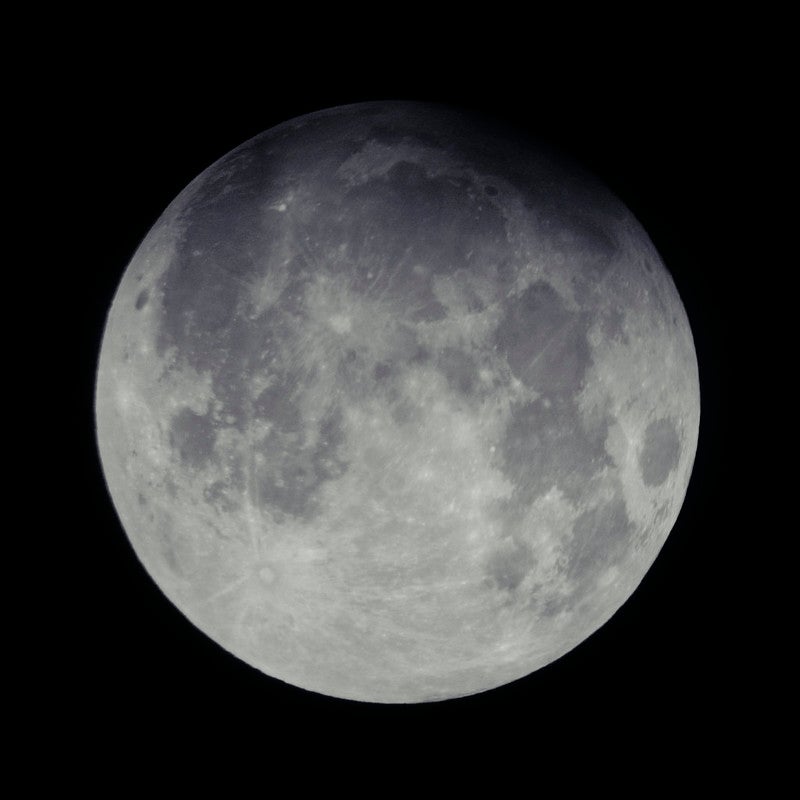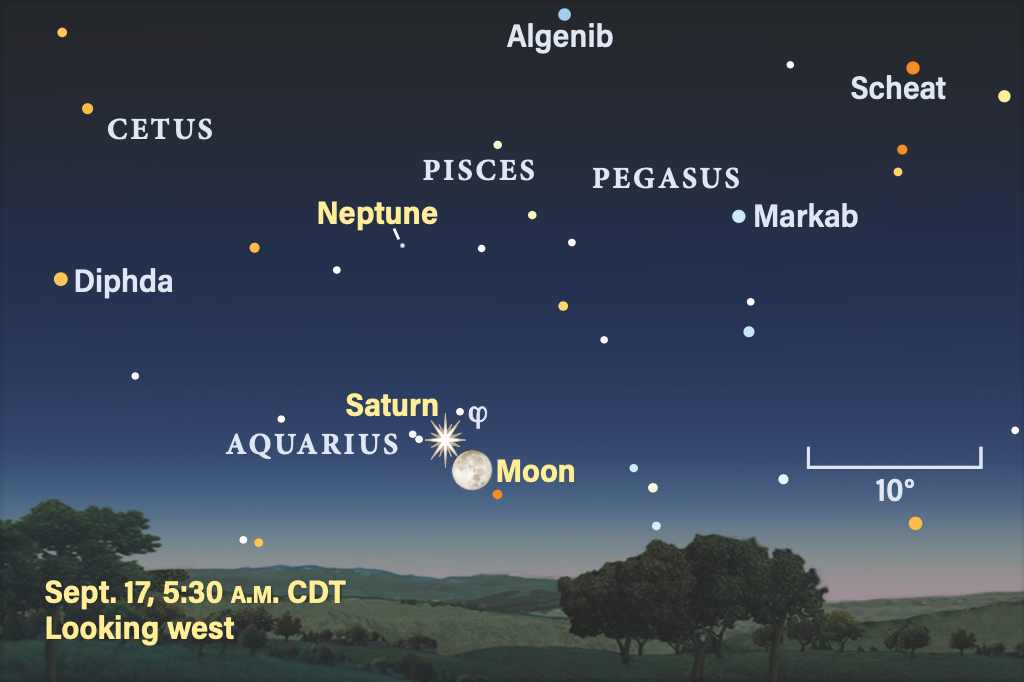
This week, we’re focused on the Moon as Tuesday brings us three amazing events.
The September Full Moon occurs Tuesday evening, bringing us the year’s Harvest Moon and the second of four stunning Super Moons of 2024.
At the same time, visible across much of the world (including the entire contiguous U.S.), the Full Moon is partially eclipsed as it passes through a portion of Earth’s shadow Tuesday evening.
Additionally, if you’re up early and ready to pregame on Tuesday morning, the Moon passes in front of the planet Saturn in the pre-dawn sky for those in the western half of the U.S. (including Hawaii) and Canada. All other observers will still see the two objects hanging close together in the early-morning twilight.
A partial lunar eclipse
Shortly before the Moon officially reaches its Full phase, something interesting begins to happen. It starts to slide into Earth’s shadow as seen from the Moon, as cosmic geometry lines up the Sun, Earth, and Moon just right.
The eclipse officially begins at 8:41 P.M. EDT, when the Moon slides into the outermost region of Earth’s shadow, called the penumbra. Although at maximum eclipse the Moon will sit entirely within the penumbra, only a small portion of the lunar limb will pass through the darker, central region of Earth’s shadow, called the umbra — this is why it is only a partial eclipse. For a total lunar eclipse to occur, the Moon must pass completely through the umbra as well.
The Moon’s northern regions will start to grow dusky compared to the rest of its bright face as Luna continues its journey through the shadow. Our satellite first starts to pass into the darker umbra at 10:12 P.M. EDT. Then, you’ll really want to focus on our satellite’s northern limb — a small sliver there should start to turn truly dark as the eclipse progresses. The partial eclipse overall lasts a little over an hour, with maximum eclipse occurring at 10:45 P.M. EDT, when just 8 percent of the Moon is within the umbra. After this, the eclipse will continue in reverse, as the northern limb slips out of the darker umbra and then the penumbra, lightening all the way. The Moon passes fully out of the penumbra at 12:47 A.M. EDT (now early on the 18th for those in the Eastern time zone only), ending the eclipse.
RELATED: Why can we still see the Moon’s disk during a total lunar eclipse?
Unlike solar eclipses, lunar eclipses of any kind are safe to observe with your naked eyes — no special protection or equipment is needed! Binoculars might help you better spot the area of the Moon that’s growing darker as the eclipse progresses, but zooming in too close — such as with a telescope — won’t really gain you much in terms of watching the eclipse. It’s best to watch with unaided eyes, though of course, using a telescope will let you explore all the unique and amazing terrain that Luna has to offer. Note, though, that doing so at Full Moon is more difficult than during other phases, as shadows are shortest because the Sun is high overhead; this is lunar “noon.”
Lunar eclipses occur slowly, giving you plenty of time to watch in what will hopefully be mild, comfortable weather. You can take some time to observe other objects around the sky in between glances at the Moon, or you can simply step outside once in a while during the eclipse to check its progress without fear of missing much if you can’t watch the entire time.
Overall, this eclipse will last roughly 4 hours from beginning to end, again with the partial phase — the most dramatic portion — lasting just over an hour. Admittedly, this partial lunar eclipse won’t cause much dramatic visible change over most the Moon, nor should it change the Moon’s color, as can occur during a Blood Moon or total lunar eclipse. Nonetheless, it’s an amazing opportunity to view celestial geometry in action, and offers a bit of a preview for the total lunar eclipse coming to North and South America next September, which will be a much flashier event.
The Full Harvest Super Moon
Just as solar eclipses can only occur when the Moon is New, lunar eclipses can only occur when the Moon is Full. This month’s Full Moon officially occurs at 10:34 P.M. EDT.
Typically, September’s Full Moon is called the Corn Moon. But this Full Moon has a special name: the Harvest Moon. This is the name bestowed upon the Full Moon closest to the autumnal equinox, which occurs next week on September 22nd.
This month’s Full Moon will also appear particularly big and bright. That’s because it’s a Super Moon, or a Full Moon that occurs around the same time that our satellite reaches perigee, the closest point to Earth in its orbit. The Moon will officially reach perigee tomorrow morning (the 18th) at 9:22 A.M. EDT, when it will be 227,007 miles (365,332 km) away.
This is the second of four consecutive Super Moons in 2024, which began with the August Full Moon and will continue with October and November’s Full Moons as well.
Related: 2024 Full Moon calendar: When to see the Full Moon and phases
Bonus: Lunar occultation of Saturn
This week’s Super Moon and lunar eclipse will be easy to observe for anyone willing to step outside in the evening. But for those early risers who look to the sky Tuesday morning, there’s even more in store, as the Moon will occult Saturn in the constellation Aquarius, visible from portions of North America as well as Hawaii.

The occultation begins around 5 A.M. MDT Tuesday morning, when the Moon and Saturn are just 10° above the western horizon in the central U.S. and some 20° high from the West Coast (note that here, it’s an hour earlier: 4 A.M. PDT). The moment Saturn will disappear is heavily dependent on your location, so check the International Occultation Timing Association’s website for the timing of disappearance and reappearance from various cities.
Saturn, at magnitude 0.6, is readily visible to the naked eye, though it will appear dimmer and harder to see as the bright, nearly Full Moon approaches. You’ll want to watch the actual occultation, as Saturn slips behind the leading edge of the Moon, through binoculars or a telescope for the best view. It will take some 30 seconds for the planet to completely disappear.
Observers in eastern North America won’t ever see the Moon cross in front of Saturn, but they will see the two close together in the morning sky, setting in the west shortly before the Sun rises in the east. From the East Coast, the Moon will pass 0.3° due north of Saturn at 6 A.M. EDT.
So, whether you’re up early or late (or willing to sacrifice a little sleep and do both), the Moon certainly has something to show off this Tuesday.
Below are the times of sunrise, sunset, moonrise, and moonset on the 17th, given in local time from 40° N 90° W. The Moon’s illumination is given at 12 P.M. local time from the same location. Note that these times may differ slightly depending on your location.
Tuesday, September 17
Sunrise: 6:43 A.M.
Sunset: 7:04 P.M.
Moonrise: 7:03 P.M.
Moonset: 5:58 A.M.
Moon Phase: Full
This information is adapted from our Sky This Week column, which provides observing tips and news each week and is published every Friday.









